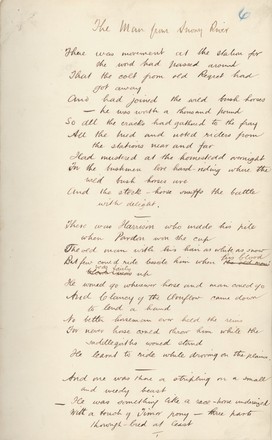The Man from Snowy River and other verses
1895
Manuscript
Acquired from Angus & Robertson, 1933
MLMSS 314 / 195 (A 1909)
First published in the Bulletin in April 1890, Banjo Patterson‘s poem ‘The Man from Snowy River’ was an instant success. While Paterson had no illusions about his writing skills – ‘Scant in their worth’, he said, ‘their merits indeed but slight’* – the poem tapped into a strengthening surge of nationalism in the lead-up to Federation in 1901.
Paterson's verse celebrated a rugged, irreverent and masculine spirit that turned away from the city to a wild and idealised bush heartland. Along with Dorothea Mackellar’s ‘My Country’ and the paintings of artists such as Arthur Streeton and Tom Roberts, Paterson’s ‘The Man from Snowy River’ and other writings helped popularise a distinctive but highly selective Australian identity that would maintain a powerful hold for generations to come.
Paterson republished the poem in 1895 in his first book The Man from Snowy River and other verses. The volume on display is an incomplete manuscript of the book. Along with `The Man from Snowy River' and other poems written in Paterson's hand, it contains typescript versions of poems, cuttings from the Bulletin and various printed extracts. It was later bound by the publisher George Robertson of Angus & Robertson.
‘The Man from Snowy River’ has been made into three films: in 1920, 1982 and a sequel in 1988. It was also a TV series, made in 1993–96, and an arena spectacular stage musical, in 2002.
Paterson’s first book The Man from Snowy River and Other Verses sold 5000 copies in the first four months after publication.
In April each year, the town of Corryong in Victoria holds the Man from Snowy River Bush festival. The festival is a celebration of the famous poem, bush folklore, the arts, music and horsemanship. The town also has a Man from Snowy River Museum.
Paterson always maintained that the Man from Snowy River was an invention, but many people think he was inspired by a horseman named Jack Riley, who Banjo met while visiting the Kosciuszko Ranges. There Paterson heard the story of Riley’s memorable ride down the mountain slopes in chase of horses. Another of Paterson’s poems, ‘Johnny Riley's Cow: a Ballad of Federation’ has been taken by many to be proof that Riley was the inspiration behind Paterson’s most famous verse.
The 1982 movie The Man from Snowy River features a number of lines from the original poem. For example, when the mountain riders go to capture the brumbies, they are told, 'No use for fancy riding now ... go at them from the jump', meaning that the riders should start and ride towards the brumbies together to prevent them from scattering.
Two characters mentioned in the early part of the poem are featured in previous poems by Paterson: ‘Clancy of the Overflow’ and Harrison from ‘Old Pardon, Son of Reprieve’.
The words of the poem ‘The
Man from Snowy River’ were set to tune by Australian country singer Slim Dusty.
Banjo Paterson and his poem ‘The Man From Snowy River’ are commemorated on the Australian $10 note. The full text of the poem is printed several times in microprint as one of the note's security devices.
Andrew Barton Paterson used the pen name Banjo, which was the name of a racehorse owned by his family.
In the 1982 movie The Man from Snowy River, actor David Bradshaw played the role of Banjo Patterson.
Published in 1905, Paterson’s Old Bush Songs was the first major collection of Australian folksongs. The publication saved many from oblivion.



 Back to list
Back to list